3. Volume of education and training
The volume of education and training is examined here in two ways: as the number of hours of instruction spent by the participant on education or training and as the expected value of instruction hours, i.e. as the number of hours of instruction per person.
The number of hours of instruction per participant refers to the number of hours of instruction the person participating in education or training received on average during the 12 months preceding the survey. The expected value of instruction hours can be calculated with the following formula:
Expected value of instruction hours in category i = (Number of participants in category i / Number of persons belonging to category i) x Average number of hours of instruction for participants in category i
In practice, the expected value of instruction hours involves multiplying the average number of instruction hours by the participation rate, in which case the resulting indicator expresses the number of hours of instruction per person, either in the entire population or in the category of some background variable.
3.1 Volume of formal or non-formal education and training per participant
Figure 4. Number of instruction hours in formal or non-formal education and training per participant during 12 months in selected European countries over the years 2005-2007 (population aged 25-64 that participated in formal or non-formal education and training)
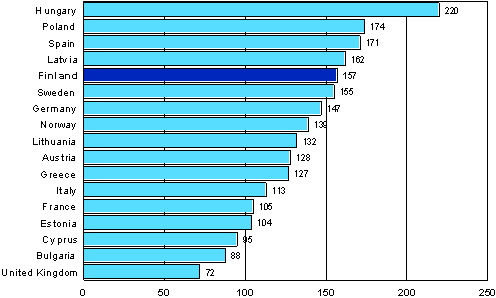
The youngest age group of participants in formal or non-formal education and training – persons aged 25 to 34 – received the most hours of instruction in all the comparison countries. Correspondingly, the number of hours of instruction for the oldest age group (persons aged 55 to 64) was lowest in all the countries other than Cyprus, Estonia and Greece. In these countries, the average number of instruction hours for persons aged 55 to 64 was the same as it was for persons aged 35 to 54.
In approximately half of the comparison countries, the average number of instruction hours for participants in formal or non-formal education and training who have a tertiary-level diploma was higher than for those with lower-level basic education (Annex Table 4). The biggest differences were in Bulgaria and Cyprus, where the average number of hours of instruction for participants with a tertiary-level diploma was more than twice as high as it was for others. Persons with a secondary degree received more hours of instruction than others on average in Finland, Greece and Hungary. In Austria, Germany, Lithuania and Norway, persons aged 25 to 64 who have completed only primary-level education received the highest number of hours of instruction. Residents of the United Kingdom received the most equal number of hours of instruction, regardless of basic education.
Persons aged 25 to 64 who are outside the labour force had more instruction hours than others in nearly all the comparison countries. This result was expected, as the group in question includes full-time students. The exceptions to this rule were France, where the average number of hours of participation by unemployed persons was nearly double that of persons outside the labour force and quadruple that of employed persons, and the United Kingdom and Austria, where the average number of hours of instruction of unemployed persons and persons outside the labour force was about the same.
3.2 Volume of formal or non-formal education and training per person
Figure 5. Number of instruction hours in formal or non-formal education and training (expected value) per person during 12 months in selected European countries in the years 2005-2007 (population aged 25-64)
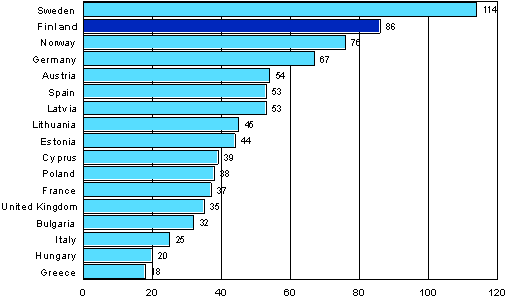
3.3 Volume of formal education and training per participant
Figure 6. Number of instruction hours in formal education and training per participant during 12 months in selected European countries during the years 2005-2007 (population aged 25-64 that participated in formal education and training)
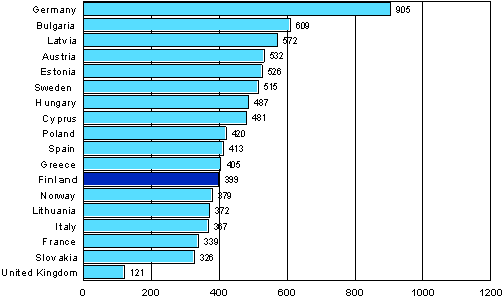
In most of the comparison countries, young people aged 25 to 34 received more hours of instruction than people older than them (Annex Table 5). There are of course some exceptions: among those who participated in formal education and training in Austria, Germany, Greece, Lithuania and Poland, those in the oldest age group (persons aged 55 to 64) received the most hours of instruction. However, in these countries, the participation rate of the age group was very low – under one per cent – with the exception of Germany. The high number of instruction hours may be explained by the fact that a handful of participants had numerous instruction hours and this has had a substantial impact on the average with the low number of participants.
As the rate of participation in formal education and training was higher for persons with a tertiary-level degree than for others in nearly all the comparison countries, the situation regarding instruction hours was almost totally the opposite. In nearly all the countries, persons aged 25 to 64 with secondary-level or lower-level education received the highest number of hours of instruction per participant. Only in Cyprus, Latvia, Slovakia and the United Kingdom was the average number of hours of instruction higher for persons with a tertiary-level degree than it was for others.
Employed persons participating in formal education and training received fewer hours of instruction on average than unemployed persons and persons outside the labour force in nearly all the comparison countries. The exceptions were Bulgaria and Germany, and employed residents in these countries received slightly more hours of instruction than unemployed persons, although they did receive fewer hours of instruction than persons outside the labour force. In the majority of countries, the average number of hours of instruction per participant was highest for persons aged 25 to 64 who are outside the labour force. This is influenced by the fact that full-time students belong to this group. In Austria, Estonia and Lithuania, unemployed persons received the most hours of instruction per participant.
3.4 Volume of formal education and training per person
Figure 7. Number of instruction hours in formal education and training (expected value) per person during 12 months in selected European countries over the years 2005-2007 (population aged 25-64)
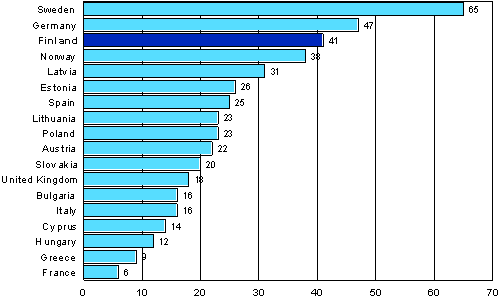
3.5 Volume of non-formal education and training per participant
Figure 8. Number of instruction hours in non-formal education and training per participant during 12 months in selected European countries over the years 2005-2007 (population aged 25-64 that participated in non-formal education and training)
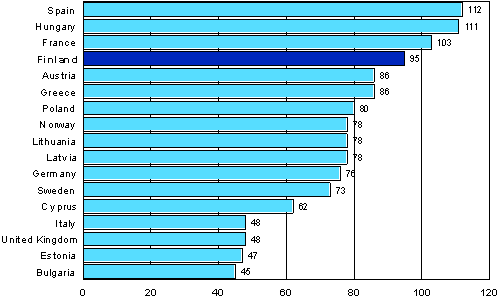
Young people aged 25 to 34 received more hours of instruction in non-formal education and training than people in older age groups in all the comparison countries except Estonia. In Estonia, persons in different age groups received approximately the same number of hours of instruction. The biggest relative differences between the youngest and oldest (persons aged 55 to 64) age groups in the number of hours of instruction per participant were in the United Kingdom and Bulgaria. In these countries, the average number of days of teaching for the youngest age group participating in education and training was around double that given to the oldest age group.
The connection between basic education and the number of hours of instruction in non-formal education and training varied from country to country. The rule of thumb is that either those who have completed only primary-level education or those who have a tertiary-level diploma receive the highest number of hours of instruction; persons with a secondary-level degree do not receive the highest number of hours of instruction in any of the comparison countries. In Spain and Hungary, however, those who have a secondary-level degree and those who have a tertiary-level degree had the same number of hours of instruction on average, and more hours than those who have only completed primary-level education. When compared with the other categories of basic education, tertiary-level degree graduates in Bulgaria received the most hours of instruction, relatively speaking . The average number of hours of instruction they received was triple that received in other countries. Among those with only primary-level education, persons living in the United Kingdom and Germany received the most days of teaching in relative terms. In Finland, the average number of instruction hours for persons with different levels of basic education were very close to each other. Among persons with only primary-level education and those with a tertiary-level degree, the average number of hours of instruction was approximately 100, and among persons with a secondary-level degree the figure was some 10 hours lower.
Among those who participated in non-formal education and training, either unemployed persons or persons outside the labour force received the most hours of instruction in all the comparison countries (Annex Table 6). Finland and Bulgaria were the only countries in which persons outside the labour force received the most hours of instruction per participant, although in Sweden unemployed persons and persons outside the labour force received the same amount of instruction. The biggest relative differences in the number of hours of instruction in favour of unemployed persons were in Austria and France, where the average number of hours of instruction of unemployed persons was double that of employed persons and persons outside the labour force.
3.6 Volume of non-formal education and training per person
Figure 9. Number of instruction hours in non-formal education and training (expected value) per person during 12 months in selected European countries over the years 2005-2007 (population aged 25-64)
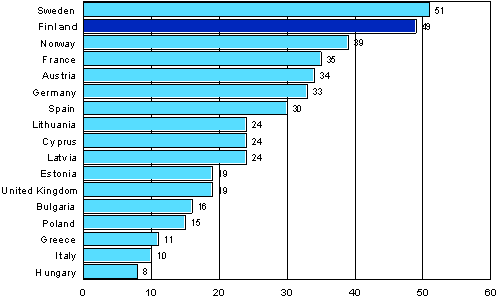
Source: EU Adult Education Survey, Eurostat
Inquiries: Timo Ruuskanen (09) 1734 3620, Irja Blomqvist (09) 1734 3221
Director in charge: Riitta Harala
Updated 24.4.2009
Official Statistics of Finland (OSF):
Participation in adult education [e-publication].
ISSN=2489-6926. European comparison 2006,
3. Volume of education and training
. Helsinki: Statistics Finland [referred: 28.12.2025].
Access method: http://stat.fi/til/aku/2006/04/aku_2006_04_2009-04-24_kat_003_en.html

